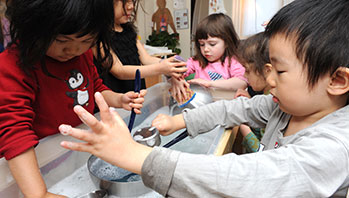- containers
- cups
- pipettes or eyedroppers
- sponges
- squirt bottles
- turkey basters
- water pumps
- wide-mouth bottle
- move
- pour
- pump
- squirt
- water
MA Standards:
Language/L.PK.MA.6: Use words and phrases acquired through conversations, listening to books read aloud, activities, and play.
Head Start Outcomes:
Logic and Reasoning/Reasoning and Problem Solving: Classifies, compares, and contrasts objects, events, and experiences.
Science Knowledge/Conceptual Knowledge of Natural and Physical Worlds: Observes, describes, and discusses properties of materials and transformation of substances.
PreK Learning Guidelines:
English Language Arts/Language 2: Participate actively in discussions, listen to the ideas of others, and ask and answer relevant questions.
Science and Technology/Earth and Space Sciences 5: Compare and contrast natural materials such as water, rocks, soil, and living organisms using descriptive language.
Science and Technology/Physical Sciences 19: Explore, describe, and compare the properties of liquids and solids found in children's daily environment.
Explore Together (indoors): From Here to There

© Commonwealth of Massachusetts, Department of Early Education and Care (Jennifer Waddell photographer). All rights reserved.
STEM Key Concepts: You can use different objects to move water
ELA Focus Skills: Listening and Speaking, Vocabulary
Educator Prep: For this activity, set up a water table or large tub of water for children to use to explore. Cover the floor with plastic. Put newspapers or towels on top. Provide water smocks (garbage bags with holes for head and arms work well). Set guidelines about splashing and squirting.
Safety Tips:
- Be sure to clean and disinfect the water table and the plastic containers daily and fill the table with fresh water each day.
- Be sure to have plenty of towels and/or a mop handy for clean-up of spills.
For this guided activity, group children into teams to figure out ways to move water from one place to another.
First, invite a small group to find as many ways as they can to move water from a container at one end of the water table to a wide-mouth bottle at the other end. Set a rule for children that they cannot pick up the water container. A sample solution might be that they use a turkey baster to carry water from the container to the bottle. Encourage them to notice the openings of the tools—are some wider than others? Which tool would fit over the opening? Which would be too wide?
After the first group has finished, invite a second group to figure out a way to move the water in the opposite direction, from the bottle to the container.
Encourage children to combine tools to solve the “problem” of getting the water from the container to the bottle and back. Let children work together to come up with solutions.
Reflect and Share
Allow plenty of time to move the water back and forth using the water tools. Once you gather children, have teams discuss what they did to get the water from the container to the bottle and back. Have them describe the challenges they faced and how they figured out solutions.
Adaptation: You may want to set up more than one table. Younger children may want to simply continue exploring moving water with their hands and not be interested in exploring the tools yet.
Adaptation: If the weather is warm, wheel your water table(s) outside or fill a plastic pool with water. Then help children do the activities outdoors, where they can explore without worrying about spills.
